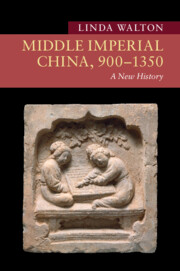Book contents
- Middle Imperial China, 900–1350
- New Approaches to Asian History
- Middle Imperial China, 900–1350
- Copyright page
- Dedication
- Contents
- Figures
- Maps
- Acknowledgments
- Introduction
- 1 The Turbulent Tenth Century
- 2 Song in a Multipolar World
- 3 Schooling, State, and Society in Song and Jin
- 4 An Economic Revolution?
- 5 Cities and Urban Life
- 6 Religious Transformations
- 7 Ways of Knowing
- 8 The Arts of Culture
- 9 Gendered and Generational Lives
- 10 Mapping the Built and Natural Environment
- 11 Sustaining Life and Healing Bodies
- 12 The Mongol Yuan Dynasty in China
- 13 Yuan China in the Mongol Eurasian Empire
- Bibliography
- Index
- New Approaches to Asian History
Introduction
Middle Imperial China in East Asian and World History
Published online by Cambridge University Press: 20 July 2023
- Middle Imperial China, 900–1350
- New Approaches to Asian History
- Middle Imperial China, 900–1350
- Copyright page
- Dedication
- Contents
- Figures
- Maps
- Acknowledgments
- Introduction
- 1 The Turbulent Tenth Century
- 2 Song in a Multipolar World
- 3 Schooling, State, and Society in Song and Jin
- 4 An Economic Revolution?
- 5 Cities and Urban Life
- 6 Religious Transformations
- 7 Ways of Knowing
- 8 The Arts of Culture
- 9 Gendered and Generational Lives
- 10 Mapping the Built and Natural Environment
- 11 Sustaining Life and Healing Bodies
- 12 The Mongol Yuan Dynasty in China
- 13 Yuan China in the Mongol Eurasian Empire
- Bibliography
- Index
- New Approaches to Asian History
Summary
Dynastic periodization has traditionally structured the chronological ordering of China’s history. The period from 900 to 1350 encompasses two major dynasties, Song (960–1279) and Yuan (1279–1367). Historians in China and elsewhere typically saw the Song as culturally vibrant and militarily weak, and the Yuan as a conquest dynasty that briefly interrupted the narrative flow of Chinese history until the restoration of “native” rule in the following Ming (1368–1644). Twentieth-century national politics recast China’s history along a linear (ancient, medieval, modern) timeline rather than a dynastic cyclical one, placing the Song and Yuan in a medieval-to-modern transition. The high degree of commercialization and monetization of the Song economy led scholars to view the Song as experiencing an economic transformation that fostered dramatic changes in Song society. Recent interest in cultural diversity as well as political concerns with the role of minority peoples – in both the People’s Republic of China and elsewhere – have drawn new attention to the Khitan Liao, Tangut Xi Xia, and Jurchen Jin empires that rose on the Song borders, as well as the Mongol conquest and rule of China as the Yuan dynasty. Middle-period China encompasses processes of political unification, social and economic transformations, and profound cultural achievements.
Keywords
- Type
- Chapter
- Information
- Middle Imperial China, 900–1350A New History, pp. 1 - 13Publisher: Cambridge University PressPrint publication year: 2023

